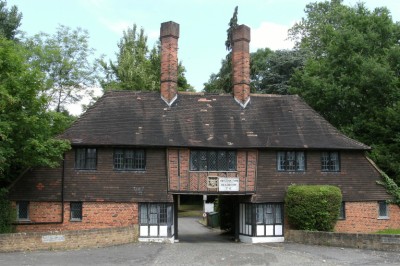
A Stanmore Walk
Route & what to see
|
|
| london-footprints.co.uk |
A 5 mile walk from Stanmore Station to Canons Park Station (both Jubilee line).
Exit station and cross
London Road.
The station was constructed on the extended Metropolitan line in
1930-2.
Go through Kerry Court into
Kerry Avenue. Left along Valencia Road.
These roads have a number of Modernist houses.
Left at Dennis Lane and
right along The Broadway.
Cotterell Cottages are dated 1565. The Ernest Bernays Memorial
Institute was built in 1870.
Right up Stanmore Hill.
The library has local information (closed Wednesdays). There are
a number of houses of interest.
Right into Wood Lane.
Stanmore Hall was built in 1843 with additions in 1888-91 which
included items by William Morris. It was rebuilt and extended
after a fire in 1979 but the Morris furnishings were lost.
Further along Springbok House is now an Islamic Centre. The
Jacobean style building was built as Warren House. Owners have
included Robert Smirke and Sir John Keyser, chairman of the Colne
Valley Water Company.
At the junction with Warren
Lane go left along the path (signposted London Loop) back to the
pond. On reaching the buildings go to the left of these then
right along Little Common.
There are a variety of attractive properties here including some
former outbuildings.
At the end go left along a
path.
There is a fish pond to the right
Cross the main road and go
left.
The site of Clutterbuck's Brewery has been replaced with housing
but the old brewery house remains. Adjacent are stables with a
weatherboarded clock turret. First Hill House was once a school.
Go back down Stanmore Hill.
There are views of the Wembley Arch
Bear right along Green Lane.
There are attractive cottages here. Further down is 'Olde
Cottage', Rylands (c1880) which includes part of a former barn
and Cherchefell Mews which is a conversion of the lodge to
Pynnacles House (burnt down in 1930).
Cross to the church.
Church Lodge was built in 1881 as a memorial to Robert Holland of
Stanmore Hall. The red brick church of 1632, financed by Sir John
Wolstenholme, was replaced by the present building designed by
Henry Clutton in 1849. A number of monuments were moved and the
old church was left to become a ruin. The new church has a
stained glass window by Edward Burne-Jones. [church website]
Note: for refreshments go
along Church Road.
Part of the manor house garden is now a public park called
Bernays Garden. Number 21 has a 18th century front on a 15th
century timber-framed building, formerly jettied. Note the
irregular roof.
To continue the walk go
along Old Church Lane.
The buildings on the left including Church House (built as a
banqueting house) were created in the 1930s from older
structures. Buildings opposite incorporate a barn rebuilt in
1730. Further along is a lodge to the manor house of 1901 which
was altered in the 1930s.
Right into Gordon Avenue.
The building on the corner was formerly Stanmore (Village)
Station. This terminus was opened in 1890 and closed to
passengers in 1952. The ornate station building was converted
into a house and the remainder of the site demolished for housing
despite efforts to save it.
Continue along the avenue.
The area to the right was the grounds of Stanmore Park. This was
designed by John Vardy in 1763 and altered in 1786 by Henry
Holland for Drummonds the bankers. It was demolished in 1938 and
has now been replaced with housing. Temple Pond and the gate
piers remain.
As the road bends to the
right go left along the footpath 'To Wolverton Road'.
This passes Stanmore Golf Club.
Go left at the road junction
then continue along old Church Lane to the right and then second
left.
Opposite are gasworks.
Left along Marsh Lane. Go
through gates to the right along a footpath.
This was the western drive to Canons Park.
Cross the railway into
Canons Park.
There are maps of the park which has toilets and cafe. The walled
garden is worth visiting. This would have been the kitchen garden
but became the George V Memorial Garden in 1938. The Canons
belonged to the Priory of St Bartholomew the Great until 1709.
James Brydges had a new mansion built in 1713-20 but this was
sold soon after his death in 1747. The fittings were sold and the
house demolished by 1753. William Hallett had a new villa built
which was enlarged in 1910 for Arthur Du Cros, founder of the
Dunlop Rubber Company. Since 1929 it has been part of the North
London Collegiate School which has added other buildings to the
site. An ornamental lake remains in their grounds and a temple in
the park.
A suggested route is via The
Spinney from the Canons Drive exit. This emerges near the church.
St Lawrence retains its Medieval west tower but the rest was
rebuilt in 1715 by John James for the Duke of Chandos. The family
mausoleum of 1735 includes figures of the duke and his two wives
by Grinling Gibbons. [church website]
Exit into Whitchurch Lane and go right to Canons Park Station.
london-footprints.co.uk 2009
Resources
Buildings of England London 3: North West by Cherry & Pevsner
There is a Friends of Canons Park organisation [website]
More on Stanmore (Village) Station [webpage]
[walklist]